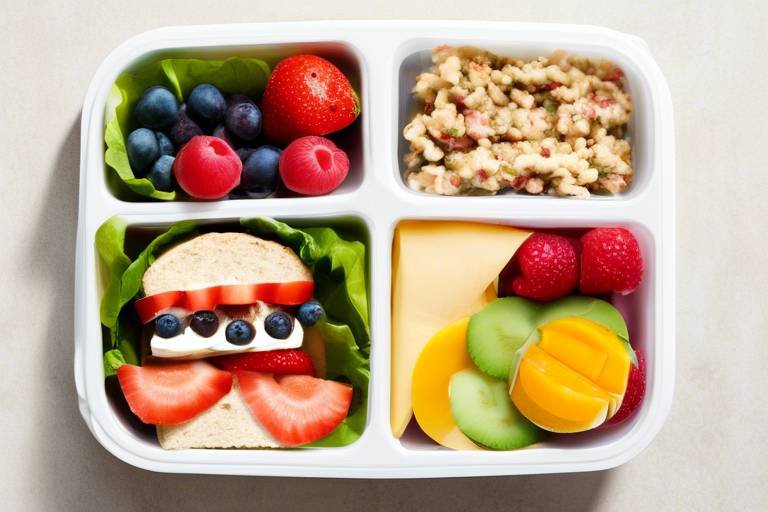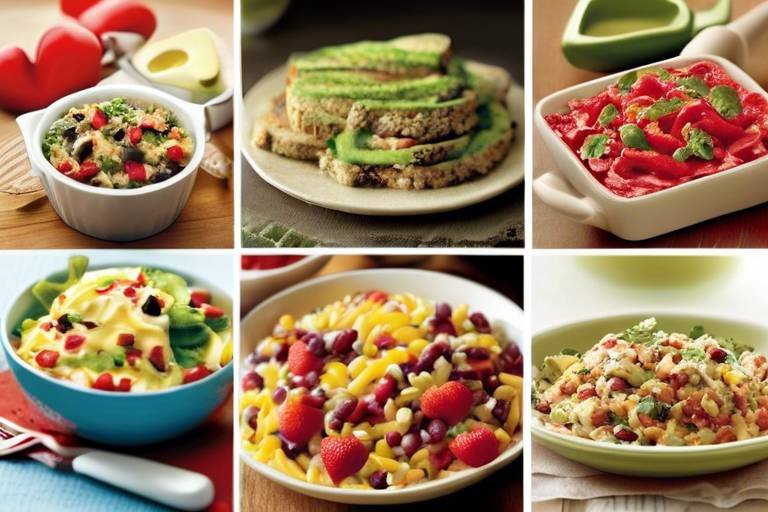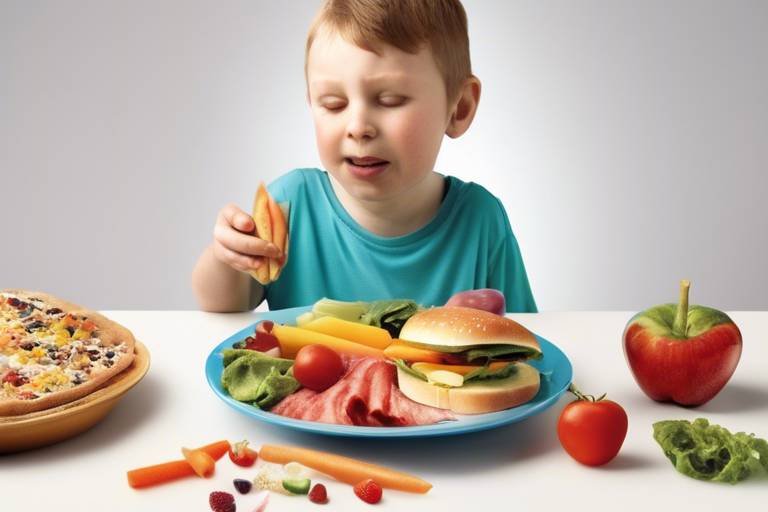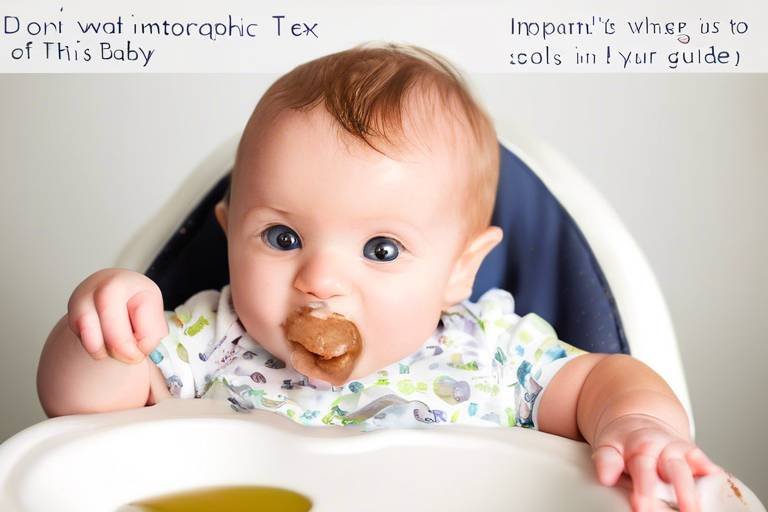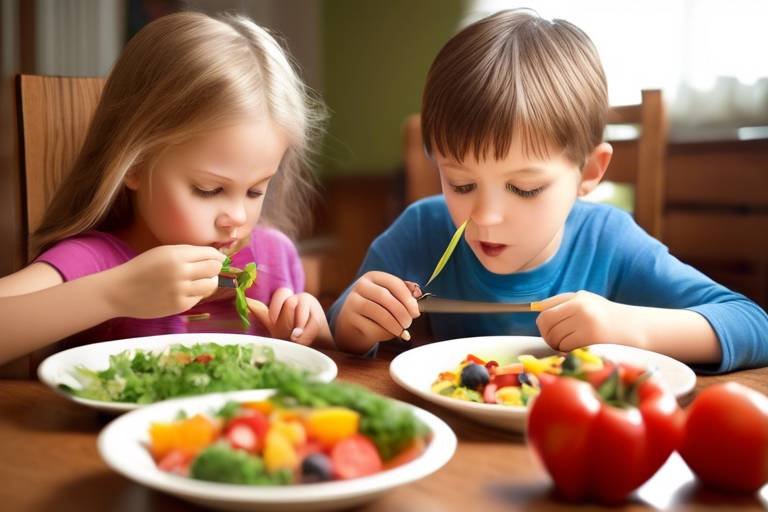How to Introduce New Foods to Your Preschooler
Introducing new foods to your preschooler can feel like a daunting task, but it doesn't have to be! It’s a journey filled with surprises, laughter, and maybe a few messes along the way. The key is to approach it with a sense of adventure and a sprinkle of creativity. Think of mealtime as a treasure hunt where each new food is a hidden gem waiting to be discovered. By fostering an environment that encourages exploration and curiosity, you can help your child develop a healthy relationship with food that will last a lifetime.
Did you know that introducing a variety of foods to your little one at an early age can significantly impact their eating habits as they grow? Research shows that children who are exposed to a wide range of flavors and textures are less likely to become picky eaters. It’s like planting seeds in a garden; the more diverse the seeds, the more vibrant the garden will be. By understanding the importance of early food exposure, you set the stage for your preschooler to embrace healthy eating habits. Not only does this help in developing their palate, but it also lays the foundation for a lifetime of nutritious choices.
A relaxed and positive mealtime atmosphere is crucial when it comes to introducing new foods. Imagine sitting down to dinner with a joyful ambiance where laughter fills the air and everyone is excited to share their day. This kind of environment encourages children to feel safe and open to trying new things. To foster this supportive dining experience, consider the following strategies:
- Make meals a family affair—share stories and experiences.
- Keep the mood light; if they refuse a food, laugh it off and try again later.
- Offer a variety of foods without pressure; let them explore at their own pace.
Engaging your preschooler in meal preparation can ignite their interest in new foods. When children help in the kitchen, they feel a sense of ownership over their meals, which can make them more inclined to taste what they’ve helped create. Simple tasks like washing vegetables, stirring ingredients, or arranging food on a plate can be empowering and fun. It’s like giving them a backstage pass to the culinary show!
When involving preschoolers in the kitchen, it’s essential to choose tasks that are safe and suitable for their age. Here are some ideas:
- Washing fruits and vegetables—this can be a fun water play activity!
- Mixing ingredients in a bowl—let them feel the textures and smells.
- Assembling sandwiches or wraps—allow them to create their own masterpiece.
Letting your child express their creativity in the kitchen can significantly enhance their excitement about food. Encourage them to experiment with colors, shapes, and flavors. For example, you could have a “rainbow plate” night where they choose colorful fruits and veggies to create a vibrant meal. This not only makes mealtime more enjoyable but also introduces them to the idea that food can be fun and artistic!
Presentation matters, especially for preschoolers! Fun and imaginative food presentation can entice them to try new foods. Think of your plate as a canvas—arranging food in fun shapes or using cookie cutters can transform ordinary dishes into exciting culinary adventures. You might create a smiley face with fruits or a colorful garden with various veggies. The more visually appealing the food, the more likely they are to give it a try!
When introducing new foods, it’s essential to set realistic expectations. Remember, it may take several exposures for a child to accept a new food. Patience is key! If they refuse a food today, don’t be discouraged. Instead, try again in a week or two. This process is much like planting a flower; it takes time and nurturing for it to bloom. By remaining positive and understanding, you can help your preschooler develop a more adventurous palate.
Keeping track of your child's reactions to new foods can provide valuable insights. Consider maintaining a food diary where you note what they tried, their reactions, and any preferences they express. This can help you identify patterns and adjust future meal planning accordingly. It’s a great way to celebrate their journey and make informed choices about what to offer next!
Finally, recognizing and celebrating even the smallest successes in trying new foods can encourage continued exploration. Whether it’s a simple high-five for trying a new vegetable or a fun sticker chart to track their progress, positive reinforcement can motivate preschoolers to keep trying unfamiliar dishes. Remember, every little step counts!
Q: How many times should I offer a new food to my child?
A: It often takes 10-15 exposures for a child to accept a new food, so don't give up too soon!
Q: What if my child refuses to eat anything but their favorite foods?
A: Gradually introduce new foods alongside their favorites, and try to make it fun and engaging.
Q: Should I force my child to eat new foods?
A: Forcing can create negative associations with food. Instead, encourage them to try it without pressure.

The Importance of Early Food Exposure
Introducing a variety of foods at an early age is not just about filling a plate; it’s about laying the groundwork for a lifetime of healthy eating habits. Think of it as planting seeds in a garden; the more diverse the seeds, the richer and more vibrant the garden will grow. When preschoolers are exposed to different flavors, textures, and colors, they are more likely to develop a positive relationship with food, reducing the risk of picky eating later on. This early exposure can also contribute to better nutrition, ensuring that children get the essential vitamins and minerals they need for their growing bodies.
Research shows that children who are introduced to a wide range of foods are more adventurous eaters. They are less likely to reject new foods outright and more likely to embrace the idea of trying something different. This is crucial because a varied diet is key to preventing nutritional deficiencies. It’s like offering a buffet of choices where the child can explore and discover their preferences. Moreover, the earlier children start trying new foods, the more comfortable they become with the idea of tasting and experimenting in the kitchen.
So, how can parents facilitate this early food exposure? Here are a few strategies:
- Start Early: Begin introducing new foods as soon as your child starts eating solids. The earlier the exposure, the better.
- Be a Role Model: Children learn by watching their parents. Show enthusiasm for trying new foods yourself!
- Make it Fun: Turn food exploration into a game. Use creative names for dishes or create a theme night around different cuisines.
Furthermore, it’s essential to remember that children may need to try a new food several times before they accept it. This is where patience comes into play. Just like learning to ride a bike, it might take a few falls before they get the hang of it. Celebrate the small victories, and don’t be discouraged by initial rejections. Each exposure is a step toward developing a more adventurous palate.
By understanding the importance of early food exposure, parents can set their children on a path toward healthier eating habits, making mealtime a time of joy, discovery, and connection. In the end, it’s not just about what’s on the plate; it’s about the experiences that come with it.
- What age should I start introducing new foods? It's best to start introducing new foods around 6 months when your child begins eating solids.
- How many times should a child try a new food? Research suggests that it may take 10-15 exposures for a child to accept a new food.
- What if my child refuses to eat new foods? Stay patient and keep offering the food without pressure. Encourage them to explore with their senses.

Creating a Positive Mealtime Environment
When it comes to introducing new foods to preschoolers, the environment in which meals are served plays a pivotal role. A positive mealtime atmosphere can make all the difference in whether your little one is willing to try that bright green broccoli or that exotic quinoa salad. Imagine mealtime as a cozy gathering instead of a battleground over what’s on the plate. By fostering a relaxed and inviting setting, you can encourage your child to explore new tastes without the pressure that often accompanies mealtime.
One of the first steps in creating this nurturing environment is to establish a routine. Children thrive on consistency, and having regular mealtimes can help them feel secure and more willing to try new foods. You might consider setting the table together, letting your child choose a fun plate or napkin, which can make the experience feel special. This simple act can turn a mundane meal into a celebration of food, sparking interest and curiosity.
Next, consider the atmosphere. Dimming the lights a bit, playing soft music, or even using candles can transform the dining experience. This doesn’t mean you need to go all out every night, but creating a pleasant ambiance can help your child associate mealtime with positive feelings. You might even want to have themed dinners where you explore different cultures through food. For example, a "Taco Tuesday" night can be a fun way to introduce various ingredients while making the experience interactive and enjoyable.
Another crucial aspect is to lead by example. Children are like little sponges, soaking up the behaviors and attitudes of those around them. If they see you enjoying a variety of foods, they are more likely to want to try them too. Share your enthusiasm! Use phrases like, “Wow, this mango is so sweet and juicy!” or “I love how crunchy this salad is!” Your excitement can be contagious, encouraging your preschooler to take that leap into trying something new.
It’s also essential to keep the conversation light and engaging during meals. Instead of focusing solely on what your child is eating (or not eating), ask open-ended questions about their day, favorite colors, or upcoming events. This can distract them from the pressure of trying new foods and create a more enjoyable experience. You might say, “What was the best part of your day?” or “If you could have any superpower, what would it be?” Such questions can shift the focus away from the food and allow your child to relax.
Lastly, remember that patience is key. If your preschooler refuses to try a new food, don’t react negatively. Instead, encourage them gently, perhaps saying, “That’s okay! You can try it another time.” Creating a supportive environment where they feel safe to explore new tastes without fear of judgment is essential for their development. Over time, with consistent exposure in a positive setting, your child will likely become more adventurous in their food choices.
Q: How many times should I offer a new food to my preschooler?
A: Research suggests that it can take anywhere from 8 to 15 exposures for a child to accept a new food. Be patient and keep offering it in different contexts.
Q: What if my child refuses to eat anything at dinner?
A: It’s important not to stress. Offer a variety of foods and allow your child to choose what they want to eat. Keep the atmosphere relaxed and avoid making mealtime a power struggle.
Q: Can I involve my child in cooking even if they are too young?
A: Absolutely! Simple tasks like washing vegetables, stirring, or arranging food on a plate are great ways to involve them in the kitchen safely.

Involving Children in Meal Preparation
Engaging preschoolers in meal preparation can be a game-changer when it comes to encouraging them to try new foods. Think about it: when kids help create something, they’re more likely to feel a sense of ownership over it. It’s like when you build something with your own hands; you take pride in it, right? Involving children in the kitchen not only sparks their interest but also makes them feel like they’re part of the process, which can lead to a more adventurous palate.
So, how do you get started? First, consider age-appropriate tasks that can safely involve your little chef. For instance, washing vegetables or stirring ingredients can be both fun and educational. These simple activities not only help develop fine motor skills but also teach them about the food they eat. You might say, “Hey, can you wash these carrots for me?” Suddenly, they’re not just eating carrots; they’re *making* them part of a meal!
Moreover, allowing children to express their creativity in the kitchen can enhance their excitement about food. Imagine letting them pick out colorful ingredients or arrange their plates in fun shapes. You could even have themed meals where they can help design the menu. This kind of involvement turns mealtime into a delightful adventure rather than just another chore. It’s like turning the kitchen into a mini art studio where food is the canvas!
To keep things organized and ensure that everyone has a role, you might want to create a simple chart of tasks that are suitable for preschoolers. For example, you could set up a table like this:
| Task | Description |
|---|---|
| Washing Vegetables | Let them rinse and scrub vegetables under running water. |
| Stirring Ingredients | Allow them to mix ingredients in a bowl. |
| Setting the Table | Involve them in placing plates, utensils, and napkins on the table. |
| Decorating Plates | Let them arrange food creatively on their plates. |
As you navigate this culinary journey together, remember to celebrate their efforts. Whether they successfully help make dinner or just enjoy the process, it’s essential to acknowledge their contributions. This positive reinforcement can motivate them to keep exploring and tasting new foods. After all, cooking together can become a cherished family tradition that not only fills bellies but also creates lasting memories.
- What age is appropriate for involving children in meal preparation?
Generally, children as young as 2-3 years can start with simple tasks like washing vegetables or stirring. As they grow older, you can introduce more complex activities. - How can I keep my child safe in the kitchen?
Always supervise your child closely, use child-safe utensils, and assign age-appropriate tasks to ensure their safety while cooking. - What if my child refuses to try new foods?
Patience is key! Continue to offer new foods without pressure, and involve them in the cooking process to spark their interest.

Choosing Age-Appropriate Tasks
When it comes to involving preschoolers in meal preparation, is crucial for both safety and engagement. At this tender age, children are naturally curious and eager to help, but not all kitchen activities are suitable for their developmental stage. The goal is to find tasks that spark their interest while ensuring they can participate without any risk. Think of it as crafting a delightful recipe where the ingredients are fun, safety, and learning!
For instance, simple tasks like washing vegetables or stirring ingredients can be perfect for little hands. These activities not only keep them engaged but also teach them valuable skills. You might be surprised to see how excited they get to wash a carrot or mix a bowl of batter! It’s all about making them feel like they are a part of the process, which can lead to a greater willingness to try what they’ve helped prepare.
Here are some age-appropriate tasks that you can introduce to your preschooler:
- Washing Fruits and Vegetables: Let them rinse off some apples or scrub potatoes. It’s a fun way to teach them about cleanliness in food preparation.
- Mixing Ingredients: Hand them a spoon and let them mix dry ingredients for a cake or salad. The tactile experience is both educational and enjoyable.
- Assembling Simple Dishes: Kids can help assemble their own sandwiches or pizzas. Give them a variety of toppings and watch their creativity shine!
- Setting the Table: This task is not only simple but also teaches them about responsibility and preparation for mealtime.
It's essential to supervise them closely and provide guidance as needed. Remember, the kitchen can be a bustling place, and safety should always come first. By allowing your preschooler to take part in these age-appropriate tasks, you're not just preparing meals; you're also creating lasting memories and instilling a love for cooking that could last a lifetime.
Q: At what age can my child start helping in the kitchen?
A: Children as young as 2-3 years old can start with very simple tasks, while more complex activities can be introduced as they grow older.
Q: How do I keep my child safe in the kitchen?
A: Always supervise your child closely, and assign tasks that are appropriate for their age and skill level. Avoid sharp objects and hot surfaces.
Q: What if my child refuses to try new foods?
A: It's normal for children to be hesitant about new foods. Encourage them gently, and remember that it may take several exposures before they accept a new dish.
Q: How can I make cooking more fun for my preschooler?
A: Incorporate games, themes, or creative presentations to make cooking an exciting adventure. Let them choose a recipe or decorate their plate!

Encouraging Creativity in Cooking
Encouraging creativity in the kitchen can transform mealtime into an exciting adventure for your preschooler. Imagine your child as a little chef, donning a colorful apron and a chef's hat, ready to explore the world of flavors! When children are given the chance to express their creativity while cooking, it not only makes them more enthusiastic about trying new foods but also fosters a sense of ownership and pride in their culinary creations.
One effective way to spark this creativity is by allowing your child to choose ingredients for a meal. For instance, you could set up a mini "market" at home with various fruits, vegetables, and proteins, and let your child pick what they want to use. This not only makes them feel involved but also teaches them about making choices and understanding different food options. You can say, “Which colorful veggie do you want to add to our dish today?” This simple question can ignite a child’s imagination and make them excited about the cooking process.
Another fun approach is to encourage your preschooler to create fun shapes and designs with their food. You can provide cookie cutters in various shapes and sizes, allowing them to cut sandwiches, fruits, or even pancakes into stars, hearts, or animals. This playful presentation can make even the most mundane foods seem exciting! For example, a simple cucumber can transform into a star-shaped slice that makes your child giggle with delight. You might be surprised at how much more willing they are to eat something that looks fun!
Moreover, consider introducing themed meals that align with your child's interests. If your little one loves dinosaurs, you could create a "Dino Dinner" where broccoli trees and meatball "dinosaur eggs" take center stage. Not only does this make eating more enjoyable, but it also provides an opportunity for storytelling during meals. Ask questions like, “What do you think our dinosaur would eat?” This encourages imaginative thinking and makes the experience interactive.
Lastly, don’t forget to celebrate their culinary masterpieces! After they’ve created a dish, take a moment to appreciate their efforts. Snap a photo of their creation and share it with family members or on social media. This recognition can boost their confidence and encourage them to keep experimenting in the kitchen. Remember, cooking should be a joyful experience, filled with laughter, creativity, and a dash of messiness!
- How can I introduce new foods without causing a fuss?
Start by incorporating small amounts of new foods alongside familiar favorites. Make it a game to see who can guess the flavor! - What if my child refuses to try new foods?
Keep offering the food without pressure. It can take several exposures before a child is willing to try something new. - Are there specific foods that are better for encouraging creativity?
Fruits and vegetables that can be cut into shapes, as well as colorful ingredients, are excellent for sparking creativity.

Using Playful Presentation Techniques
When it comes to getting preschoolers excited about trying new foods, presentation is everything. Imagine serving a plate of broccoli and carrots just plopped down in a heap. Now picture the same vegetables arranged into a fun shape, like a dinosaur or a colorful rainbow. Which one do you think would spark a child's interest? By using playful presentation techniques, you can transform mealtime into an adventure that encourages your little ones to explore new flavors and textures.
One effective method is to create themed meals. For instance, if your child loves a particular movie or character, you can design a meal around that theme. Think of a “Frozen” meal with blue smoothies, snowflake-shaped sandwiches, and snowy white cauliflower. This not only makes the food visually appealing but also connects it to something your child loves, making them more likely to try it.
Another technique is to use fun dishes and utensils. Brightly colored plates, quirky-shaped bowls, or even animal-themed cutlery can make the dining experience feel like a game. You can also encourage your child to create their own “food art.” Provide them with a variety of ingredients and let them arrange their plates however they like. This not only engages their creativity but also gives them a sense of ownership over their meal, making them more inclined to taste what they’ve created.
Don’t forget about color and variety! A plate that looks like a rainbow, filled with different colors and shapes, is much more enticing than a monochrome meal. Try to include a mix of textures and colors in every dish. For example, a salad with bright cherry tomatoes, crisp cucumbers, and crunchy bell peppers can be visually stimulating. You might even consider using cookie cutters to create fun shapes with fruits and vegetables, making them more appealing to young eyes.
Lastly, consider incorporating storytelling into mealtime. You can describe the origins of the food or create a fun tale around it. For instance, tell your child that the peas are tiny green superheroes ready to give them energy. This narrative approach not only makes the food more interesting but also helps children form a connection with what they are eating.
In summary, using playful presentation techniques can significantly enhance your preschooler's willingness to try new foods. By making meals fun, colorful, and engaging, you can turn mealtime into a delightful experience that fosters a love for healthy eating.
- What are some quick ways to present food playfully? Use cookie cutters to create fun shapes, arrange food into characters, or serve meals in colorful dishes.
- How can I encourage my child to eat vegetables? Create a veggie rainbow on their plate or tell a story about the veggies being superheroes!
- What if my child refuses to try new foods? Remain patient, celebrate small victories, and try different presentation techniques to make food more appealing.

Setting Realistic Expectations
When it comes to introducing new foods to your preschooler, it's crucial to set realistic expectations. Kids are often unpredictable, and their taste buds can be just as fickle as the weather. One day they might love broccoli, and the next, they may turn their nose up at it. This is completely normal! Understanding that it can take several attempts before a child accepts a new food is key. In fact, research suggests that it may take anywhere from 10 to 15 exposures to a new food before a child is willing to try it. So, don’t be discouraged if your little one refuses that new veggie on the first try.
Another important aspect to consider is the mood and environment during mealtime. If your child is tired or distracted, they are less likely to be open to trying something new. Try to create a calm and inviting atmosphere at the table. This could mean turning off the TV, putting away toys, and perhaps even playing some soft music in the background. The goal is to make mealtime a stress-free experience where your child feels comfortable exploring new flavors.
It's also beneficial to remember that peer influence plays a significant role in a child's willingness to try new foods. If your child sees siblings or friends enjoying a particular dish, they might be more inclined to give it a shot themselves. So, if you have the opportunity, arrange playdates or family meals where everyone is trying new foods together. You can even turn it into a game! For example, you might say, "Let's all take a bite of this new food at the same time!" This can create a sense of camaraderie and make the experience less intimidating.
Lastly, keep in mind that patience is a virtue. Every child is different, and some may take longer than others to warm up to new foods. Celebrate the small victories, like your child smelling a new fruit or taking a tiny nibble. These little steps are worth recognizing and can encourage your preschooler to continue exploring new tastes. Just remember, it’s all about the journey, not just the destination. By setting realistic expectations and maintaining a positive outlook, you can help your child develop a healthy relationship with food that lasts a lifetime.
- How many times should I introduce a new food to my child? It is generally recommended to offer a new food at least 10 to 15 times before determining if your child likes it.
- What should I do if my child refuses to eat a new food? Stay calm and avoid pressure. Encourage them to try it again later, and consider involving them in meal prep to spark their interest.
- Can I use dips or sauces to make new foods more appealing? Absolutely! Dips like hummus or yogurt can make new vegetables more enticing. Just ensure the dips are healthy.
- Is it okay to let my child skip meals if they refuse to eat? Yes, children will naturally eat when they are hungry. Avoid forcing meals, as this can create negative associations with food.

Tracking Progress and Preferences
When it comes to introducing new foods to your preschooler, tracking their progress and preferences can be a game changer. Imagine this: you’re on a journey, and every little stop along the way teaches you something new about your child’s tastes and habits. Keeping a close eye on what your little one enjoys—or doesn’t—can help you tailor future meals to their likes, making mealtime less of a battle and more of a culinary adventure.
One effective way to monitor your child’s reactions to different foods is by maintaining a food diary. This doesn’t have to be a tedious task; think of it as a fun scrapbook of flavors! You can jot down notes about each meal, including what was served, how your child reacted, and any comments they made. This not only helps you identify their favorites but also pinpoints any foods they may be hesitant to try again. It’s like being a detective in the world of food, uncovering clues about what makes your child tick when it comes to taste.
Consider creating a simple table to log this information. Here’s a quick example to illustrate how you might set it up:
| Date | Food Served | Reaction | Comments |
|---|---|---|---|
| 2023-10-01 | Broccoli | Refused | “It looks weird!” |
| 2023-10-02 | Carrots | Liked | “Crunchy and sweet!” |
| 2023-10-03 | Quinoa | Mixed | “It’s funny!” |
As you compile this data, you may notice patterns emerging. For instance, does your child prefer foods that are crunchy over soft? Are they more adventurous with colors or shapes? Taking note of these preferences not only helps in planning meals but also boosts your child’s confidence as they see their tastes being acknowledged.
Don’t forget to celebrate the small victories along the way! If your child tries a new food, even if they don’t love it, make it a big deal. A simple “Wow, you tried something new today!” can go a long way in encouraging them to keep exploring. Positive reinforcement is key; it’s like giving them a gold star for their bravery in the culinary world!
Ultimately, tracking progress and preferences is about creating a positive food experience for your preschooler. By making this process engaging and fun, you can turn mealtime into an exciting opportunity for discovery rather than a chore. So grab that food diary, start logging those meals, and watch as your child’s palate expands in delightful ways!
- How long does it usually take for a child to accept a new food? Every child is different, but it can take anywhere from 5 to 15 exposures for them to accept a new food.
- What should I do if my child refuses to eat a new food? Keep it positive! Encourage them to try just a small bite and don’t pressure them. Sometimes, just seeing the food on their plate can help.
- Are there any foods I should avoid introducing to preschoolers? Yes, be cautious with foods that are choking hazards, such as whole grapes or nuts, and always consult with your pediatrician about any allergies.

Celebrating Small Victories
When it comes to introducing new foods to your preschooler, every little success counts! Celebrating small victories is not just about acknowledging the act of trying a new food; it’s about building a positive relationship with food that can last a lifetime. Think of it like planting a seed in a garden. With care and attention, that seed can grow into a beautiful flower. Similarly, when your child tastes a new fruit or vegetable, it’s a step towards a more adventurous palate. So how can you effectively celebrate these moments?
First, recognition is key. When your child tries something new, whether it's a bite of broccoli or a spoonful of quinoa, make sure to highlight their bravery. Use enthusiastic phrases like, “Wow, you tried the green food! That’s amazing!” This not only boosts their confidence but also reinforces the idea that trying new foods is a positive experience. You can even create a fun little ritual, such as a high-five or a special cheer, to mark the occasion.
Another effective strategy is to incorporate fun visuals. Consider creating a “Food Adventure Chart” where your child can place stickers or draw stars every time they try a new food. This not only makes the process tangible but also adds an element of excitement. You might create a simple table like the one below to track their progress:
| Date | Food Tried | Reaction | Sticker Earned |
|---|---|---|---|
| 01/10/2023 | Broccoli | Liked it! | ⭐ |
| 01/12/2023 | Quinoa | Not sure... | ⭐ |
| 01/15/2023 | Strawberries | Loved it! | ⭐ |
Lastly, don’t forget to celebrate the effort, not just the outcome. Even if your child doesn’t love the new food right away, acknowledging their willingness to try is crucial. You can say things like, “I’m so proud of you for giving it a shot! We can try it again later.” This approach fosters a sense of resilience and encourages ongoing exploration.
In conclusion, celebrating small victories in the journey of introducing new foods can create a positive atmosphere around mealtime. By recognizing their efforts, using visual tracking, and emphasizing the joy of trying new things, you can help your preschooler develop a healthy relationship with food that encourages curiosity and adventure.
- How many times should I offer a new food? It's often recommended to introduce a new food at least 10-15 times before determining if your child likes it or not.
- What if my child refuses to try new foods? Stay patient and avoid pressuring them. Encourage them to explore the food without forcing them to eat it.
- Can I mix new foods with familiar ones? Absolutely! Mixing new foods with favorites can make them more appealing.
- What are some fun ways to present new foods? Try using cookie cutters to create fun shapes or arrange foods into smiley faces to make them more inviting.
Frequently Asked Questions
- What are some effective strategies for introducing new foods to my preschooler?
One effective strategy is to involve your child in meal preparation. Letting them wash vegetables or stir ingredients can spark their interest in the food they help create. Additionally, using playful presentation techniques, like arranging food into fun shapes or themes, can make new dishes more appealing.
- How can I create a positive mealtime environment?
Creating a relaxed and supportive dining atmosphere is key. Try to minimize distractions and make mealtime a family event. Encourage open conversations about food, and avoid pressuring your child to eat. This helps them feel comfortable exploring new flavors and textures.
- How many times should I offer a new food before my child might accept it?
It's common for children to need multiple exposures to a new food before they accept it. Research suggests that offering a new food 10-15 times can increase the likelihood of acceptance. Patience is crucial, so celebrate small victories along the way!
- What age-appropriate tasks can I give my preschooler in the kitchen?
Consider tasks that are simple yet engaging, such as washing fruits and vegetables, stirring ingredients, or arranging food on plates. These activities not only keep them safe but also make them feel like they’re part of the cooking process, which can encourage them to try new foods.
- How can I track my child's progress with new foods?
Keeping a food diary can be incredibly helpful. Record what new foods your child tries and their reactions to them. This can help you identify preferences and adjust future meals accordingly, making the process more tailored to their tastes.
- What should I do if my preschooler refuses to try new foods?
If your child refuses to try new foods, don’t force them. Instead, keep offering the food without pressure. Sometimes, just having it on their plate can make them curious. Remember, it’s all about creating a positive experience around food.
- How can I encourage my child to be more adventurous with food?
Encouraging creativity in cooking can be a game changer! Let your child pick out a new recipe or choose ingredients at the store. The more involved they are, the more likely they are to be excited about trying new dishes!
- Is it normal for preschoolers to be picky eaters?
Yes, it’s completely normal for preschoolers to go through phases of picky eating. This is often a part of their development as they learn to express preferences. The key is to remain patient and continue to offer a variety of foods without pressure.












